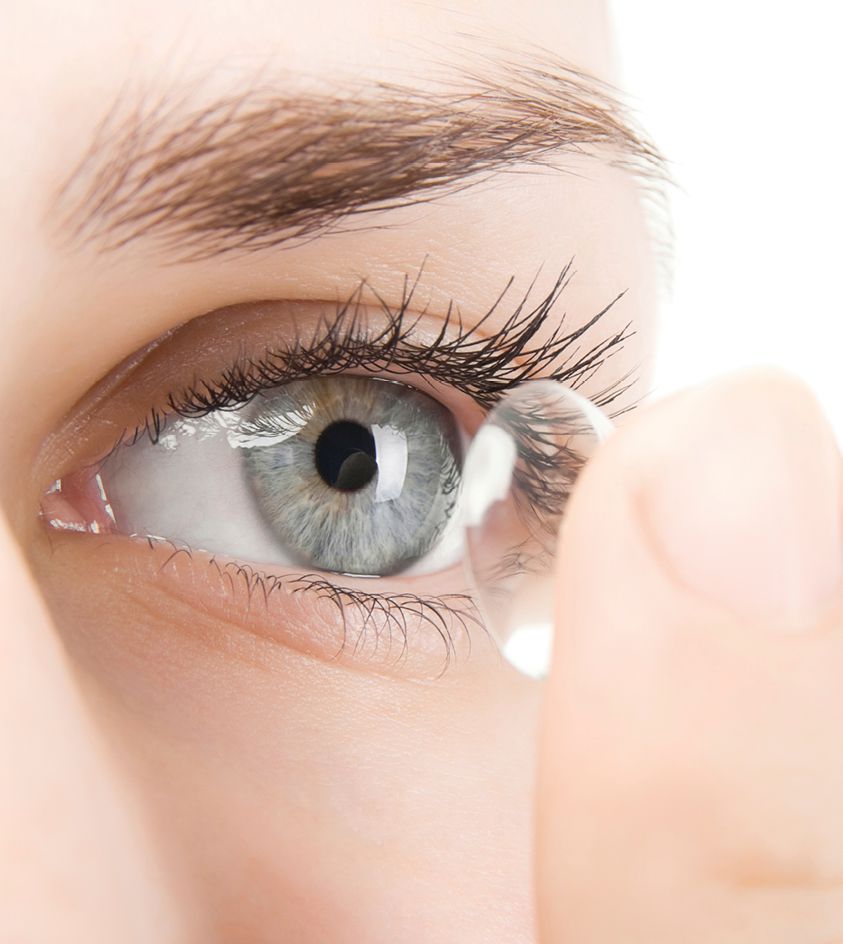Introduction
Contact lenses are medical devices that, when placed on the eye can correct shortsightedness, farsightedness and astigmatism. They can also be worn for cosmetic or therapeutic reasons.
People choose to wear contact lenses for many reasons. Aesthetics and cosmetics are often motivating factors for people who would like to avoid wearing glasses or would like to change the appearance of their eyes. Other people wear contacts for more visual reasons. When compared with spectacles, contact lenses typically provide better peripheral vision, and do not collect moisture such as rain, snow, condensation, or sweat. This makes them ideal for sports and other outdoor activities.
Additionally, there are conditions such as keratoconus and aniseikonia that are better corrected with contact lenses than glasses.
Although contact lenses have been available for over a century, the development of PMMA (polymethyl methacrylate) or Perspex promoted the development of plastic corneal hard contact lenses. In 1971 the first soft contact lens was approved by the American Food and Drug Administration. Since then the advancements in both material and design have made contact lenses first choice for over 15% of the world’s population.
The prescribing of contact lenses is restricted to eye-care practitioners (Optometrists and Ophthalmologists). The best type of lens will be prescribed based on your visual requirements, eye structure and tear quality. Although your contact lens prescription is usually similar to your spectacle prescription the two are not interchangeable.
The many types of contact lenses currently available can be grouped in various ways according to:
- Function
- Material
- Wearing schedule
- Design of the lens

Functions of
Contact Lenses
Prescription Contact Lenses:
Corrective contact lenses are designed to improve vision. Conditions correctable with contact lenses are myopia (shortsightedness), hypermetropia (farsightedness), astigmatism and presbyopia.
Cosmetic Contact Lenses:
A cosmetic contact lens is designed to change the appearance of the eye. These lenses are available with or without prescription and carry the same risk of complications as any other contact lens. It is for this reason that even zero-powered lenses are classified as medical devices and a contact lens examination is essential before first use.
Therapeutic Contact Lenses:
Contact lenses may be used in the management and treatment of various disorders of the eye. For example, a bandage contact lens is used to prevent the eyelid rubbing against an injured or diseased cornea.
Contact Lens
Materials
Hard lenses:
Hard lenses are made from a rigid plastic material called PMMA. Their main disadvantage is that no oxygen is transmitted through the lens to the cornea.
RGP (Rigid Gas Permeable) lenses:
RGP (Rigid Gas Permeable) lenses started development during the 1980s. Their rigid structure and high oxygen transmission make them ideal for higher prescriptions and patients with keratoconus. In addition, RGP lenses are not hydrophilic and do not absorb vapours or liquids, making them suitable for use in many industrial environments.
Soft Lenses:
Soft lenses are made from gel-like, water-containing plastics. Whilst rigid lenses require a period of adaptation, soft lenses are immediately comfortable.
Contact Lens
Designs
Many lens designs are available to correct various types of vision problems:
Spherical Contact Lenses:
Spherical Contact Lenses are prescribed to correct myopia (shortsightedness) or hyperopia (farsightedness).
Toric Contact Lenses:
Spherical Contact Lenses are used to correct astigmatism.
Multifocal Contact Lenses:
Multifocal Contact Lenses contain different zones for near and far vision to correct presbyopia.
Contact Lens Wear and Care
Which Contact lens is
right for you?
Lenses are available in a multitude of combinations of diameter, curvature and material. Your Optometrist will judge the best lens for you based on good vision, fit, comfort and wearing schedule.
He/she will also ensure that the final lenses prescribed will not interfere with the physiology of the eye.
Wearing and Replacement Schedule
Replacement Schedule
Shorter replacement cycle lenses are commonly thinner and lighter, due to lower requirements for durability against wear and tear, and may be the most comfortable in their respective class and generation. These may be best for patients with ocular allergies or other conditions because it limits deposits of antigens and protein, and is considered the healthiest wear schedule due to the most frequent replacement. Single use lenses are also useful for people who use contacts infrequently, or for purposes (e.g., swimming or other sporting activities) where losing a lens is likely.
Disposable lenses: discard every two to four weeks as prescribed by your practitioner.